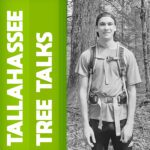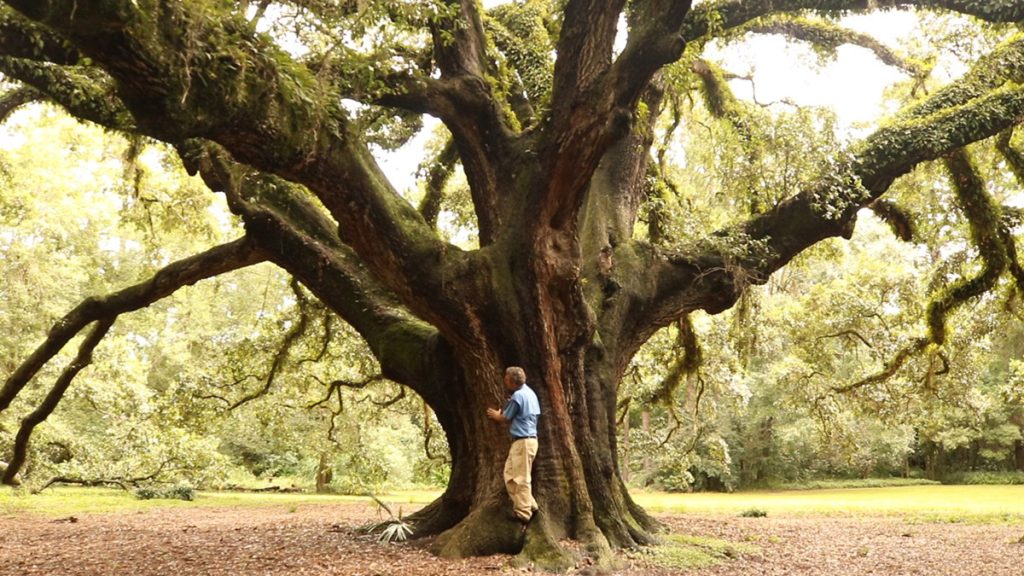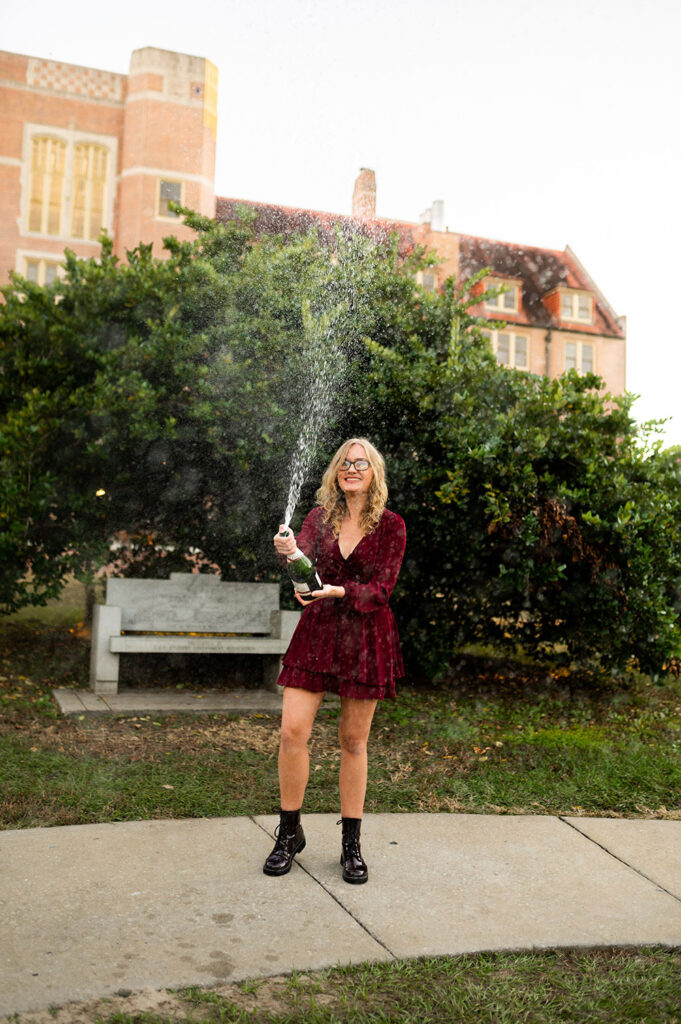
Hi! My name is Daniel Siegel. I’m a Master’s student studying English literature at Florida State University. And I recently made a podcast. It’s called Tallahassee Tree Talks, and in it, I talk with people in Tallahassee about trees (the name is pretty on point).
I didn’t originally set out to make a podcast. Tallahassee Tree Talks came about after I asked one of my professors, Dr. Alison Sperling, if she knew of any local environmental-related opportunities over the summer. She told me about a grant being offered by a nonprofit organization she helps to run, the Sunshine State Biodiversity Group (SSBG). The goal of the grant was to fund a student project that engaged people in Tallahassee with environmental or ecological issues, and they were hoping it would relate to trees in some capacity. So I started looking into trees, about which I knew pretty much the normal amount for a person to know, which isn’t much. As I researched, it very quickly made sense why the SSBG wanted the project to focus on trees. Tallahassee is an official Tree City, USA, and it’s also a tree city, lowercase—we have a lot of trees, a lot of types of trees, and a lot of people who care deeply about trees. Trees are integral parts of the look, feeling, and culture of Tallahassee. I tried to figure out why this was the case and what impact it had on the way trees are managed and the ways people interact with them. There was a lot to discover, but the point of the project wasn’t just for me to learn about trees. It was to engage the community. As I got in contact with Tallahassee citizens who were involved with trees, it became clear that the trees in this city are interesting, but the relationship between the trees and the people is even more so. This was the story I wanted to tell.
I realized pretty quickly that I can’t be the Lorax for Tallahassee’s trees or for its people—I haven’t lived here for long enough, and I frankly just didn’t have the requisite tree knowledge. The people I was going to be talking to knew more than I did and could explain it better than I ever could. So I decided to cut out the middle man. I would record my conversations and let Tallahassee’s tree community speak for itself. I would’ve let the trees speak for themselves as well, but while the sound of wind rustling through leaves is a pleasant one, it didn’t make for the most engaging podcast.
I stuck with the podcast idea, despite the inevitable jokes about having become another white guy with a podcast. I enjoyed the conversations I had tremendously, and I hope you all do too.
Premiering Wednesday, October 16 on Apple, Spotify, Pandora, and YouTube Music! New episodes will drop on Wednesdays.
Getting hands-on with audio production
Alright, so that’s the “why” of Tallahassee Tree Talks. Time to dive into the “how.”
Dr. Andy Opel, of the Florida State University School of Communications, was kind enough to provide me with all the equipment I needed to make high-quality recordings—a Zoom recorder, wired and wireless lavalier microphones, condenser mics, dynamic mics, and of course cables galore. All this equipment was a bit overwhelming, but in retrospect, having gotten to the digital side of the audio production, I miss how straightforward the analogue bit was. There are only so many buttons and dials on a Zoom recorder. There are hundreds of settings in audio production software programs.
All this gear, thankfully, just barely fit in my backpack—along with one more cable, my bike lock. My transportation for the summer was lower-tech than my recording equipment. This was the first time I’ve spent a summer in Florida, and as was to be expected, I showed up to every single interview sweaty—sorry to all my guests!\

Stan Rosenthal: Managing a “City in a Forest” (episode 1)
The first interview was with Stan Rosenthal, who is basically the closest you can get to being a local tree celebrity. We met in the offices of the Florida Forestry Association, a building in which each room is made from a different kind of wood. The setting was perfect for the first episode of a tree podcast, and Stan was the perfect guest. He was patient and encouraging as I fumbled around untangling cables and calibrating wireless lav mics for my first actual interview. Well, first recording if you don’t count the test recordings of me talking to myself that are currently lurking in some dusty corner of my hard drive. Stan also gave me a fantastic overview of the trees in Tallahassee and North Florida in general. I kept my conversation with him as the first episode of the podcast for this reason. Talking to Stan first was also a great idea, because he knows everyone in Tallahassee’s tree community. After we finished, he gave me a list of phone numbers to call for other people to reach out to (a list that included Sam Hand and Bill Armstrong, who did end up as guests on the podcast). And he called someone up and set up my second interview on the spot.
All in all, a great first interview. But there were some hiccups along the way. Halfway through my conversation with Stan, my Zoom recorder’s batteries died. Swapping those out was easy (I had plenty of spares with me), but when I got home and plugged the SD card into my computer, the file for the interrupted recording wouldn’t play. After a minute or two of panic—Did I seriously just lose almost an hour of audio? Am I going to have to ask Stan if I can interview him again?—I started googling and found my way to a forum with others who had encountered the same issue. Everything worked out fine, and I started leaving the Zoom recorder plugged in during interviews. Even if the file can be recovered, it’s hard to bring back the momentum when a conversation is paused to swap out some batteries.
Ann Bidlingmaier: The History and Legacy of Tree Preservation in Tallahassee (episode 2)
I was excited for the second interview. Not only had Stan spoken highly of her, the name Ann Bidlingmaier had also popped up all over the place when I was doing background research on trees in Tallahassee. This was a big one. I had to be prepared. The night before the interview, I wrote out all my questions, inventoried and checked the charge on all my equipment, and loaded up my backpack. I had my sunscreen out, I had my water bottles filled…I was ready to go. It turns out I prepared for the wrong sort of Florida weather. It was storming the whole day when I interviewed Ann—you can hear the raindrops on her car roof at the end of the episode, when she takes me on a neighborhood tour. I biked out to Ann’s house, which is near Lake Jackson, without incident. This was a major win already. Tree risk came up repeatedly in the podcast, but we never mentioned the risk posed by a pile of wet leaves on a sharp turn, which increases your odds of skidding out significantly. And piles of leaves were everywhere after the tornadoes this past summer. Ann was incredibly knowledgeable—she not only gave me insight into the history of Tallahassee’s tree preservation laws, but also some of the inside scoop of how recent development has been able to sidestep some of those standards.
I felt self-conscious through the whole conversation. I had two reasons for this. One was that I was still pretty new to this podcast thing. The other was that raincoats only really cover the upper half of your body, so I spent the interview dripping all over Ann’s dining room and left a very damp cushion on one of her dining room chairs. I didn’t have to worry—I should’ve known that anyone who’s that nonchalant when describing how she stood in front of a bulldozer to save a tree wouldn’t care about a few drops of water on her carpet.
I got back laden with far more content than I had expected. Creating an episode after speaking with Ann took more than just listening through our conversation. Ann had also brought out an old box of newspaper and magazine article clippings, which I had spent a few minutes scanning before she took me around her neighborhood to point out the most interesting trees. I also realized I needed to look into the history of tree preservation before the 1980s, when Tallahassee Tree Watch was founded and introduced some of the city’s tree ordinances. So creating my conversational podcast became less of a digression from my English literature studies than I had expected when I got to study local tree history from Carolyde Phillips O’Bryan’s The Live Oak Trail.
Chase Clough: Arboreal Influencer (episode 4)
Next up was something I had encountered during my time at Florida State—the FSUTrees instagram account, which features student-submitted photos of trees on campus. I reached out to the creator, Chase Clough, who told me about the creation of the account and about how deeply FSU students care about the trees on their campus. There was another hiccup during this interview, this time external to the recording equipment. Chase’s roommate was doing laundry, and the washer’s spin cycle came on partway through our conversation. Rather than interrupt, I just kept the recording running and hoped the thumping of the laundry would be too far away to be picked up by our microphones. When I got home, I pulled on my headphones to listen to the recording, hoping for the best. For a while, everything sounded great…but then there it was. An irregular thump, thump, thump from the washing machine. Time for more googling. Luckily for me, modern audio production software is very good at recognizing background noise and removing it. This was another learning experience. In later interviews, I tried to make sure fans were turned off and phones were silenced, but I also knew not to worry when a minifridge kicked in partway through a conversation. I knew how to handle it.
Chase told me that someone else had taken over running FSUTrees and was kind enough to get me in contact with her successor, Claudia Liebeskind, a professor in FSU’s History Department. Claudia had some fascinating insights about the most popular submissions to the instagram page. People like animals, and they like trees, and apparently putting the two together is a recipe for success.

David McManus: Campus Forestry (episode 3)
After learning how important the trees on FSU’s campus are to its students, I got to learn about how the natural life on campus is planted and maintained. I spoke to David McManus, FSU’s resident arborist and tree expert. Not only did I get to dive deeper into the principles of urban forestry, I also got answers to some questions that I had been personally sitting on for a few years. The citrus trees by the Johnston building are satsumas, and it is not only permissible but encouraged to eat them and other edible plants at FSU.
Sam Hand, Angel Forde, and Edwin Duke: Extension: Protecting and Teaching the Public (episode 7)
Next up was something new—an interview with multiple guests. I spoke with Sam Hand, Angel Forde, and Edwin Duke, employees of FAMU Cooperative Extension. This conversation was particularly fun for me. Each of my three guests had a different area of specialization when it came to trees, so I could ask about pretty much anything and get an informed, interesting response. And, being extension agents, their explanations were thorough and comprehensible—who better to teach me about trees than people whose job it is to do so? The best part was that, when you have three guests, they begin to respond to each other. I hardly even had to ask questions. This conversation gave me a better understanding of tree risk. Trees are nuanced! They provide incredible benefits, but there is a cost to living in a city filled with trees.
Trees have been tremendously important to the city of Tallahassee for a long time, but this past summer was also an unusually interesting time to be looking into trees in this region. The May 10th tornadoes caused an unprecedented amount of damage to trees, and the trees caused damage to buildings and cars throughout the city. Hard for trees not to be on your mind when there are downed limbs everywhere you look and chainsaw noises are inescapable.
Bill Armstrong: Tree Care: Proper Pruning and When to Leave Things Alone (episode 8)
I learned about tree risk and hazard from several of my guests, but talking with Bill Armstrong, owner of Armstrong Tree Service, in the aftermath of the summer’s tornado damage, was particularly fascinating. Bill explained what factors make a tree likely to fail in a windstorm and the strategies for maintaining tree health to minimize this risk. He also told me about some of the safety standards for those chainsaws I had been hearing all summer. By the time I spoke with Bill, I had heard a lot of negatives about the current state of tree protection and conservation in Tallahassee. Talking to a tree service owner whose primary goal is to avoid removing trees boosted my hopes that Tallahassee can continue to be a tree city, lowercase and uppercase.

Katie Kehoe, Keith Roberson, and Andy Opel: Managing an Artistic Ecosystem (episode 6)
My optimistic side also got a boost when I learned more about the Rooting-Branching art project at Florida State University. Student tree involvement at FSU doesn’t end with people submitting photos to FSUTrees on instagram. The Rooting-Branching project involved planting native fruit and nut trees at Florida State and pairing them with augmented reality artwork created by art students. I had the chance to interview Katie Kehoe and Keith Roberson of the FSU Department of Art about why they started the project and the impact it had on their students. I brought things full circle when I interviewed Andy Opel, who was also involved in the project, with his own recording equipment.
Craig Moore III: Trees, Technology, and Art: Cables and Wires, Roots and Branches (episode 5)
Hearing about young people’s deepening involvement with trees was great, and I got to interview one of the Rooting-Branching artists as well, Craig Moore III. His excitement and passion for North Florida’s natural spaces was infectious, even though a lot of the work he’s doing with VR and AR technology went straight over my head.
Listen to Tallahassee Tree Talks starting _____
It was an educational summer. I learned how to calibrate a wireless lavalier mic and how to remove white noise from a recording. I learned how dense Live Oak wood is and how big a tree’s DBH can be before you have to get a permit to cut it down. I learned what DBH means: diameter at breast height. I learned what percentage of Tallahassee is covered with tree canopy, and I learned what laws are in place to attempt to maintain this canopy coverage.
I learned how connected people in Tallahassee are to their trees, how much trees are valued and appreciated. And I learned what changes we have to make to keep these trees we care so much about around—and the consequences that will result if we don’t.
Yes, now there is one more white guy with a podcast out there. But if I’ve managed to teach people just a fraction of what I learned, there will also, hopefully, be an increased understanding and appreciation of the trees in Tallahassee.
I hope you like the podcast! If you enjoy the first episode, the remaining 7 episodes will be releasing weekly, one every [DAY OF WEEK]. If you don’t enjoy it, we’re going to be releasing the rest anyways (but you don’t have to be happy about it).
Massive thanks to the SSBG, for funding the podcast; to Andy Opel, for equipping it; to WFSU, for hosting it; and most importantly, to all of my guests, for being the podcast. And thanks to the trees as well, for everything they do for us.
This podcast was sponsored by a grant from the Sunshine State Biodiversity Group, a Tallahassee-based non-profit committed to conservation, education, and outreach related to biodiversity and rewilding in the state of Florida.
